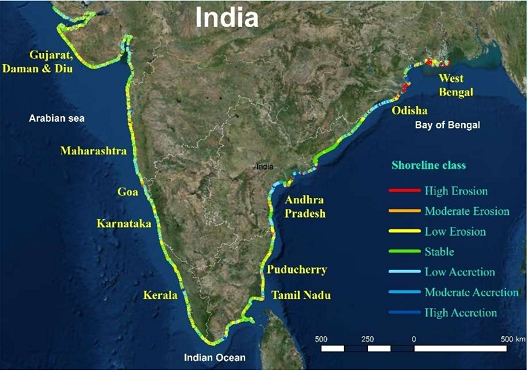
Important for UPSC, State PCS
Prelims: Climate Crisis, Global Warming, Coastal Ecosystems
Mains: General Studies Paper 3 Global Sea-level Rise
Why in the News?
‘Sea level rise scenarios and inundation maps for selected Indian coastal cities’ titled report was published by a Bengaluru-based think tank, the Centre for Study of Science, Technology and Policy (CSTEP).
How climate change is leading to sea level rise?
- Global Warming: Rising sea levels are primarily driven by global warming, which leads to increased temperatures worldwide. As temperatures rise, glaciers and ice sheets melt, adding water to the ocean.
- Thermal Expansion: Global warming also warms the ocean, causing thermal expansion, where warmer water expands in volume. This thermal expansion phenomenon contributes significantly to sea level rise.
- Ice Melting and Heat Expansion: From the 1970s until the last decade, both melting ice and thermal expansion were roughly equal contributors to observed sea level rise. However, the melting of mountain glaciers and ice sheets has accelerated in recent years.
- Accelerated Melting: Studies have shown accelerated melting rates, such as glaciers in Greenland melting five times faster than in the previous 20 years.
- Shift in Contributions: The NOAA report highlights a shift in contributions to sea level rise, with the amount due to melting nearly doubling between 2005 and 2012 compared to thermal expansion.
What is the Scenario for India?
- Rate of Sea Level Rise:
- According to the Ministry of Earth Sciences, on average, the sea level along the Indian coast was observed to be rising at a rate of about 1.7 mm/year during the last century (1900-2000).
- A 3 cm sea level rise could cause the sea to intrude inland by about 17 meters. At future rates of 5 cm/decade, this could be 300 metres of land taken by the sea in a century.

Steps taken by Government of India
- Protection and Control of Coastal Erosion in India: Central Water Commission has published guidelines in 2020 to provide the preliminary design parameters for suitable coastal protection works for different stretches of coastline.
- Coastal Vulnerability Index (CVI): Indian National Centre for Ocean Information Services has estimated CVI for the Indian coastline.
- Which is a cumulative impact of seven coastal parameters i.e., shoreline change rate, sea-level change rate, coastal elevation, coastal slope, coastal geomorphology, significant wave height and tidal range.
- National Disaster Response Fund (NDRF): Under 15th Finance Commission, recovery and reconstruction window of NDRF for Rs. 1000 crore is earmarked for resettlement of displaced people affected by erosion.
- Coastal Regulation Zone Notification, 2019: Notified by Ministry of Environment, Forest and Climate Change with a view to conserve and protect coastal stretches, marine areas and to ensure livelihood security to the fisher and other local communities.
- Mangrove Initiative for Shoreline Habitats and Tangible Incomes (MISHTI):The plan is to comprehensively explore developing 540 sq. km of mangrove forests across 11 states and 2 union territories over the next 5 years, starting from FY 2023-24.
- Shelterbelt plantations: Tightly planted rows of trees on the shoreline play a major role in preventing coastal sea erosion. For example-at coastal district of Ramanathapura
Adaptation strategies for Sea-level rise
- Build flood barriers to protect infrastructure:
- Ecosystem-based coastal protection: E.g., Oyster beds along the coast can serve as natural breakwaters.
- Man Made structures: E.g., seawall is a structure made of concrete, masonry or sheet piles.
- Conduct sea-level rise and storm surge modelling: Modelling sea-level rise and storm surge dynamics will better inform the placement and protection of critical infrastructure.
- Floating Cities: Development of these cities started in Maldives and South Korean which will be flood proof.
- Integrated Coastal Zone Management: Aim to promote security of life and livelihood of coastal communities, protect coastal ecosystems and to promote sustainable development.
- Push for a Climate Action Plan: Many cities and states do not have plans to address climate change, which is the primary cause of current sea level rise.
Initiatives to Address Sea Level Rise
National:
●Coastal Regulation Zone (CRZ):
●The Coastal Regulation Zone (CRZ) was established in 1991 to regulate coastal areas within 500 meters from the high tide line (HTL) and the land between the low tide line (LTL) and HTL.
●Recent regulations under CRZ consider the impact of rising sea levels due to global warming.
●National Action Plan on Climate Change:
●Launched in 2008 by the Prime Minister’s Council on Climate Change, this plan aims to raise awareness among various stakeholders about climate change threats and mitigation strategies
International:
●Relocation Strategies:
○Coastal cities like Kiribati Island and Indonesia’s capital Jakarta are planning relocation to mitigate the impacts of sea level rise. Kiribati plans to shift to Fiji, while Jakarta is relocating to Borneo.
●Construction of Sea Walls:
○Indonesia initiated the construction of a Giant Sea Wall, also known as “Giant Garuda,” in 2014 to protect coastal areas from flooding.
●Implementation of Enclosures:
○Researchers have proposed projects like the Northern European Enclosure Dam (NEED) to enclose bodies of water like the North Sea, Persian Gulf, Mediterranean Sea, Baltic Sea, Irish Sea, and Red Sea to shield Northern European countries from rising seas.
●Innovative Architectural Solutions:
○Cities like Rotterdam in the Netherlands have adopted innovative architectural features such as barriers, drainage systems, and “water squares” with temporary ponds to manage water flow and mitigate flooding
CBL Practice Questions for Prelims
What is the primary cause of global sea level rise?
A) Volcanic activity
B) Melting of glaciers and polar ice caps
C) Increased rainfall
D) Oceanic currents
Answer: B) Melting of glaciers and polar ice caps
CBL Mains Practice Question
Examine the impact of sea level rise on biodiversity, particularly in coastal and marine ecosystems. What steps can be taken to protect these vulnerable habitats?




Leave a Reply
You must be logged in to post a comment.